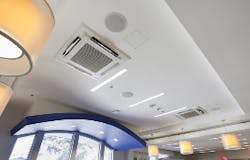The popularity of variable refrigerant flow comfort systems has become very evident to some of the nation’s leading HVAC distributors, by the rate of sales they’re seeing. One of those distributorships is Mingledorff’s Incorporated, based in Norcross,Ga.Founded in 1929, Mingledorff’s is a leading distributor of HVAC equipment with 35 locations throughout Alabama, Florida, Georgia, Mississippi and South Carolina. Mingledorff’s has been a Carrier brand distributor for 79 years.
As a representative of Carrier VRF systems, the Mingledorff’s team has seen significant increase in the number of VRF systems it has sold across its region.
Matt Prather, P.E., CEM, BEMP, LEED AP, Engineering Manager for Mingledorff’s, Inc., said the movement of VRF units from its storehouse has been steady over the past five years, a positive indicator of their popularity.
“The fact that VRF demand is ‘steady’ means that it has become an accepted HVAC technology. If it were not fully accepted, we would be seeing peaks and valleys in demand,” Prather said.
“Where comfort is paramount, VRF is an option to pursue. And, the zoning capabilities of VRF are almost beyond that of anything else. That’s one of the keys to its popularity,” he said.
Prather said commercial HVAC contractors who are considering offering VRF to a potential building owner client, should ask how long the owner intends to hold onto the property. If the owner intends on keeping the building for a minimum of five years, and is also paying the utilities, VRF makes sense from a lifecycle cost perspective.
“We’ve seen empirical data that shows a 30- to 40% year-over-year savings with VRF when compared to a traditional, packaged rooftop unit.” Prather said. “It won’t be as dramatic of a savings when compared to a high-efficiency water source heat pump, but it’s very efficient nonetheless.”
Prather said VRF has become a go-to option for many school boards, particularly for use in K-12 facilities.
“They will use an RTU or chilled water system for gymnasiums or cafeterias, but for the classroom areas, K-12 will almost always be ideal,” he said.
The only exception is in areas where humidity control is critical — such as in a hospital operating room — or in any space where very low temperatures and humidity control are required.
Suitable to precisely match the building’s cooling and heating demands, Carrier® VRF systems utilize a 2-pipe system for both heat pump and heat recovery. The heat recovery system uses a multi-port distribution controller which acts as a central location allowing better refrigerant distribution to all indoor units. These systems typically take less piping and connections to configure between outdoor unit multi-port distribution and indoor units.
CLICK HERE to read about a Carrier VRF installation at a California charter school. For other projects, visit bit.ly/CarrierVRFCaseStudies.
About the Author
Terry McIver
Content Director - CB
As director of content for Contracting Business, he produces daily content and feature articles for CB's 38,000 print subscribers and many more Internet visitors. He has written hundreds, if not two or three, pieces of news, features and contractor profile articles for CB's audience of quality HVACR contractors. He can also be found covering HVACR industry events or visiting with manufacturers and contractors. He also has significant experience in trade show planning.
